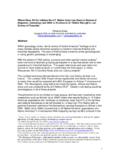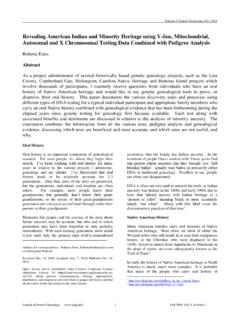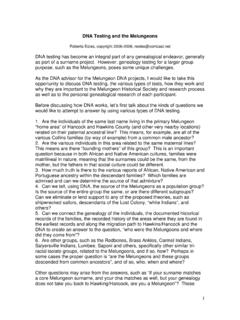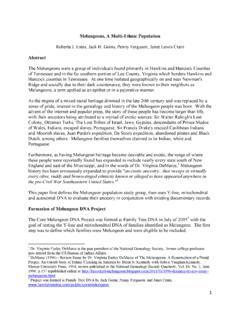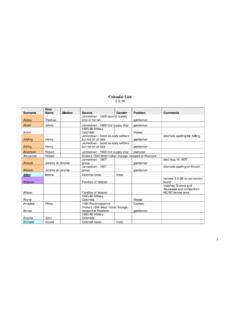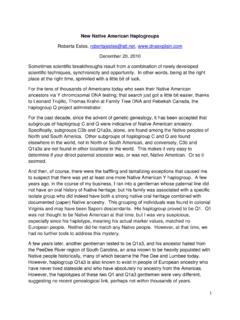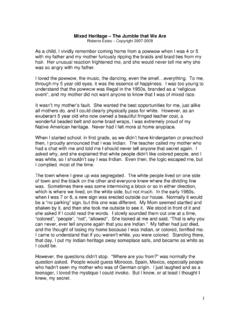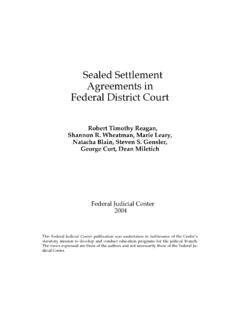Transcription of Identifying Cherokee Ancestors - DNAexplain
1 Identifying Cherokee Ancestors By Roberta Estes, copyright 2011 The only way to positively identify a Cherokee , Creek, Choctaw, Chickasaw or Seminole ancestor, aside from DNA testing, is though the tribal rolls. The Cherokee only accept individuals whose Ancestors can be found on the Dawes and/or Guion Miller rolls as members. There are additional requirements as well, so neither DNA testing nor an ancestral connection via the rolls assures one of membership today. Tribal rolls were a way for the government to identify Native people or their descendants both prior to removal and afterwards for various reasons, including payments due to treaty violations.
2 Native people were at once both anxious for the payments and very suspicious of the government, breeding a kind of love/hate relationship. This suspicious tendency and governmental distrust often carries over into the culture today. Many and now most of the rolls are now searchable via AccessGenealogy, but they are not browsable if you just want to skim the rolls. This resource can be found here: When I have been able to find a resource online that is browsable, I have included the link. The Dawes and Guion Miller are very large and overwhelming without an index, so I have included a printed resource for those books.
3 An act of Congress dated March 3, 1893 provided for a commission to negotiate with the Cherokee , Choctaw, Creek, Chickasw and Seminole Nations of Oklahoma to dissolve their tribal governments and to allot their land to individual citizens. Senator Henry Dawes was appointed to commission chairman. In 1998 the Curtis Act was passed that provided a new roll be created that superseded all previous rolls. Citizens of the tribe were enrolled under the following categories: Blood Marriage Minors (born during enrollment period) Freedmen (former slaves) Delaware (adopted into Cherokee Nation) The Dawes Rolll was supposed to be the final roll that would dissolve the Cherokee Nation forever, but this was not to be.
4 In the 1970s, the Cherokee under new leadership rose from the ashes and a new tribe was once again created using those same Dawes Rolls. 1. Dawes Rolls - A 1962 payment was made to living Cherokee individuals whose ancestor appeared on the Dawes Roll. It was necessary at that time to complete the "proof of death and heirhsip" application. If you have any relatives who received this payment, they identified their ancestor and proved the relationship on the Dawes Commission Rolls. Information on this application includes the name, roll number and place and date of death of the person on the roll and their descendants.
5 The Dawes Rolls are available on microfilm and in printed format, but were not initially indexed. The microfilm is still not indexed, but a book is available of the Dawes Rolls titled "Dawes Roll 'Plus'" by Bob Blankenship. This book includes information from the Guion Miller Roll taken in 1906 for those on both rolls. 2. Guion Miller Roll - A US Court of Claims decision on May 18, 1905 resulted in members of the Eastern Cherokee living either east of west of the Mississippi, not including Old Settler, to be entitled to participate in a monetary award by the court for various treaty violations.
6 In order to participate, one had to be alive on May 28, 1906 and estalish themselves as a member of the Eastern Cherokee or a descendants of a member living at the time of the violated treaties. Over 48,000 applications were filed representing over 90,000 individuals. Of this number 3436 east of the Mississippi and 27,284 west of the Mississippi were certified by a Mr. Miller as being eligible for the award. The book "Guion Miller Roll 'Plus'" by Bob Blankenship details the testimony of each person, whether they were accepted or rejected and the reason, plus updates the info from the Dawes Rolls were applicable.
7 These rolls are particularly important because they give into back to 1851 about Ancestors as well as the Native names, which are helpful in researching earlier rolls, as well as extended family members. You can take their application number and contact the National Archives at the Fort Worth branch (4900 Hemphill Street or their PO Box 6216, Fort Worth, Texas 76115) for their entire Guion Miller/Dawes application packet. Searchable index at - 3. If your Ancestors are on either of these rolls, you can then use their information to search the following rolls as well: Reservation Roll - 1817 - A listing of those applying for a 640 acre tract in the East in lieu of removing to Arkansas.
8 This was only good during their lifetime and then the property reverted back to the state. Armstrong Roll - 1834 - The location of Reservations under The Choctaw Treaty of the 27th of September, 1830. Each Choctaw head of a family being desirous to remain and become a citizen of the States, shall be permitted to do so, by signifying his intention to the Agent within six months from the ratification of this Treaty. Emigration Roll - 1817~1835 - Those Cherokee who filed to emigrate to Arkansas country, and after treaties in 1828 on to Oklahoma.
9 These Cherokee became known as the Old Settlers after the Eastern Cherokee joined them in 1839 Henderson Roll - 1835 History - Census of over 16,000 Cherokee residing in Alabama, Georgia, Tennessee and North Carolina to be removed to Oklahoma under the terms of the treaty of New Echota in 1835. See Trail of Tears Roll below. Trail of Tears Roll - 1835 - This is actually a report from the Secretary of War, in compliance with resolutions of the Senate, statements showing the persons employed, the funds furnished, and the improvements valued under the Cherokee Treaty of December 1835.
10 There are actually two different rolls called by this name, both completed in 1835. Ha Cubbees Band Muster Roll - 1847 - Muster roll of a party of immigrant Choctaw Indians of the Ha Cubbees Band who arrived at Fort Coffee, in the Choctaw Nation West, on the 23 of June 1847. Muster Roll of Big Black River Band - 1847 - Muster roll of a party on immigrant Choctaw Indians, known as the Big Black River Band who arrived at Fort Coffee, in the Choctaw Nation West on the 10th of June 1847. Mullay Roll - 1848 - A census of 1,517 Cherokee remaining in North Carolina after the removal of 1838.
